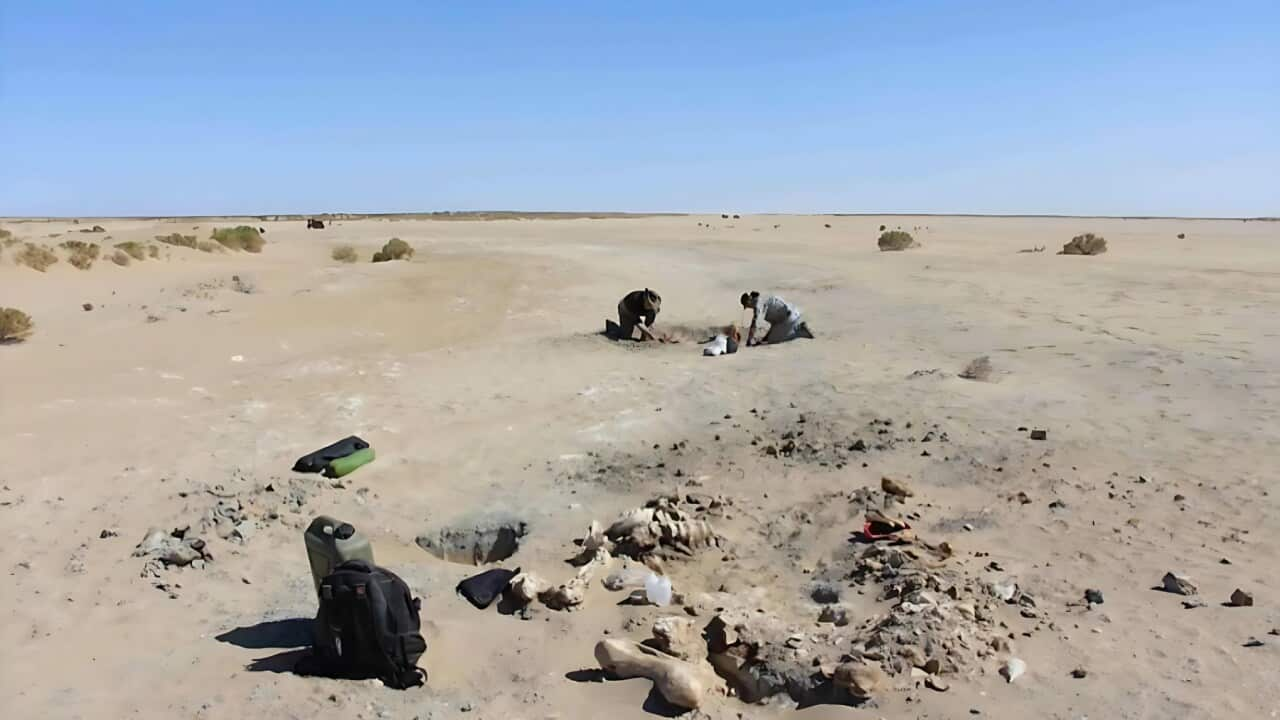English
A near perfect fossilised skeleton found in the South Australian desert has been the key to solving a 150-year-old megafauna mystery.
Giant kangaroos known as Protemnodon were first described in 1874 by British naturalist Sir Richard Owen, who differentiated them by their teeth, as was the custom of the time.
"The teeth turned out to be very variable, a lot more variable than Owen thought, and so basically for 150 years it's been really difficult to tell how many species there were and how to tell them apart."
That’s the voice of Palaeontologist Dr Isaac Kerr who is the lead researcher on the Flinders University study.
He’s examined hundreds of Protemnodon bones in museums across Australia, New Guinea, the UK and even the US, using a 3D scanner.
But it was an archaeological site at Lake Callabonna in arid South Australia where an important clue was unearthed.
The discovery of fossilised skeletons that had similar teeth. but very different bodies.
"The main tip off in the end was that proportions of the hind limb were very different between species and that's a strong indicator of kangaroos of a difference in locomotion and speed and efficiency of their hop. We talk about gearing, so slow or low gearing mid gearing and high gearing. So a red kangaroo has a very short femur, a very short upper leg and a very long shin bone. That helps the body to stay over the foot when they are hopping. Some did have that, others had about the same size femour and shin bone which similar to a tree kangaroo.”
The research which is published in the journal Megataxa led to the formal description of three Protemnodon species.
Protemnodon Viator lived in arid areas and was twice as big as a large red kangaroo.
Here’s what Isaac Kerr says about the viator.
“Very large, up to 170 kilograms with very long hind limbs. It was probably a fairly fast and efficient hopper. Not so quick and good as hopping as say a red kangaroo but similar in some respects and that was spread across Arid Australia. “
Another species - Protemnodon mamkurra was more robust, thick-limbed and slower moving, thought to have returned to forested areas on the southern coast from Western Australia to Tasmania.
Here’s Dr Kerr again.
"Some Protemnodon returned to densely forested habitat in places like new guinea, and Tasmania and the east coast of Australia and in that habitat it doesn’t pay to have such a quick efficient hop that you see in open habitat kangaroo, it’s much better to be slower moving and a bit more nimble to move through thick undergrowth so then you end up with kangaroos a bit more like a quokka or a potteroo."
A third species - Protemnodon dawsonae was described from fewer fossils and remains more of a mystery.
It was most likely a mid-speed hopper. something like a swamp wallaby
The new discoveries will enable researchers to expand the knowledge of what these giants were getting up to.
"People can look at how they interacted with their environment, you know, did they move in mobs like living kangaroos do, did they box like living kangaroos."
Now researchers are heading to New Guinea where they hope to describe another giant kangaroo.
Italian
Uno scheletro fossile quasi perfetto ritrovato nel deserto dell'Australia meridionale è la chiave per risolvere un mistero vecchio 150 anni sulla megafauna.
I canguri giganti, noti come Protemnodonti, furono descritti per la prima volta nel 1874 dal naturalista britannico Sir Richard Owen, che li differenziò in base ai denti, come era consuetudine all'epoca.
"The teeth turned out to be very variable, a lot more variable than Owen thought, and so basically for 150 years it's been really difficult to tell how many species there were and how to tell them apart."
Questa è la voce del paleontologo Isaac Kerr, ricercatore capo dello studio della Flinders University.
Kerr ha esaminato centinaia di ossa di Protemnodonte nei musei dell'Australia, della Nuova Guinea, del Regno Unito e persino degli Stati Uniti, utilizzando uno scanner 3D.
Ma è stato un sito archeologico presso il lago Callabonna, nell'arida Australia meridionale, a portare alla luce un importante indizio.
La scoperta di scheletri fossili con denti simili, ma corpi molto diversi.
"The main tip off in the end was that proportions of the hind limb were very different between species and that's a strong indicator of kangaroos of a difference in locomotion and speed and efficiency of their hop. We talk about gearing, so slow or low gearing mid gearing and high gearing. So a red kangaroo has a very short femur, a very short upper leg and a very long shin bone. That helps the body to stay over the foot when they are hopping. Some did have that, others had about the same size femour and shin bone which similar to a tree kangaroo.”
La ricerca, pubblicata sulla rivista Megataxa, ha portato alla descrizione formale di tre specie di Protemnodonte.
Il Protemnodonte Viator viveva in zone aride ed era grande il doppio di un grosso canguro rosso.
Ecco cosa dice Isaac Kerr sul viator.
“Very large, up to 170 kilograms with very long hind limbs. It was probably a fairly fast and efficient hopper. Not so quick and good as hopping as say a red kangaroo but similar in some respects and that was spread across Arid Australia. “
Un'altra specie, il Protemnodonte mamkurra, più robusta, con arti spessi e più lenta, si pensa sia tornata nelle aree boschive della costa meridionale dall'Australia occidentale alla Tasmania.
Ecco di nuovo il dottor Kerr.
"Some Protemnodon returned to densely forested habitat in places like new guinea, and Tasmania and the east coast of Australia and in that habitat it doesn’t pay to have such a quick efficient hop that you see in open habitat kangaroo, it’s much better to be slower moving and a bit more nimble to move through thick undergrowth so then you end up with kangaroos a bit more like a quokka or a potteroo."
Una terza specie, il Protemnodonte di Dawson, è stata descritta a partire da un numero minore di fossili e rimane ancora un mistero.
Molto probabilmente si trattava di un saltatore di media velocità, simile a un wallaby delle paludi.
Le nuove scoperte permetteranno ai ricercatori di ampliare le conoscenze su cosa facessero questi giganti.
"People can look at how they interacted with their environment, you know, did they move in mobs like living kangaroos do, did they box like living kangaroos."
Ora i ricercatori si stanno recando in Nuova Guinea dove sperano di descrivere un altro canguro gigante.




